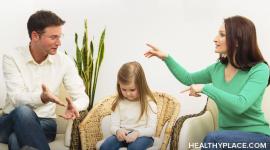Parenting with PTSD: Preventing Secondary PTSD in Your Children

Parenting with PTSD can be rough. Posttraumatic stress disorder involves intense symptoms that involve intrusions like reliving the trauma through flashbacks, nightmares, distress, and physical responses; negative emotions and thoughts, memory and processing problems; and loss of interest in activities and detachment from people—including family. These symptoms can be harmful to children; however, developing an awareness of PTSD’s negative effects can lead to proper treatment and a positive outcome for everyone.
Why is Parenting with PTSD so Difficult? Can it Cause Secondary PTSD in Kids?
Children can trigger PTSD reactions in their parent who lives with traumatic stress. This is, of course, completely unintentional; really, it’s simply a product of kids being kids. Kids are noisy. They yell, scream, run, stomp, throw things, drop things, and slam doors. Any loud or sudden noise can induce a trauma response.
Traumatic stress disrupts the way someone parents. Caring for children takes energy, effort, patience, presence, and engagement, but PTSD symptoms can inhibit these requirements.
Further, trauma changes how a parent interacts with their kids. Operating from a place of fear leads to different parenting behaviors, commonly:
- Extreme overprotection, imposing unhealthy restrictions to keep kids out of danger
- Anger, lashing out inappropriately, yelling and screaming
Just as parenting with PTSD is difficult, having a parent with PTSD is hard. Trauma reactions aimed at children, while unintentional, can be damaging. Some kids even develop secondary PTSD.
A Parent’s PTSD Can Be Harmful to Kids
Children respond to and are shaped by their parents. When a parent has PTSD, kids are inadvertently affected in multiple ways.
When parents lash out, kids often blame themselves and feel ashamed that they cause these reactions. Additionally, when parents lash out at them or keep them isolated and avoid going places and doing fun things with them, kids believe that they’re unloved. Self-esteem is damaged at a young age.
Witnessing flashbacks is terrifying for children and causes them to worry excessively about their parent. They also begin to worry about their own wellbeing and whether their parent can take care of them.
Children often take on unhealthy roles in response to a parent’s traumatic stress. Keeping in mind that each child is unique, kids frequently react by:
- Taking on an adult role and becoming the rescuer, assuming the parent’s duties to try to make things better for them
- Withdrawing, internalizing feelings, and becoming emotionally uninvolved at home and school—this can lead to anxiety, depression, and relationship problems
- Overidentifying with the parent, which typically causes secondary PTSD
In secondary PTSD, a child absorbs the trauma of their parent. The parent’s trauma becomes their own trauma, and they manifest it the way their parent does, sharing the emotional and behavioral reactions. Symptoms of secondary PTSD in a child are very much like symptoms of PTSD in their parent.
Because of secondary PTSD or any of the other reactions to a parent’s experiences, children can develop social, behavioral, and emotional problems. They often have difficulties in school because concentrating is hard when their mind is preoccupied with PTSD at home.
Traumatic stress doesn’t have to permanently ravage the person with PTSD or their family.
Help is Available for Families Impacted by PTSD
Help is available in numerous forms for the parent with PTSD, their children, and the family unit. Healing can happen at all levels—cognitive, emotional, behavioral, and physiological (the body’s response to the trauma). And when children receive treatment early, it’s possible to prevent the development of secondary PTSD.
Professional help has options. Help is available individually. Each parent works on their own with a therapist—CBT, talk therapy, and virtual reality exposure therapy are particularly useful for treating PTSD—and children work individually with their own child-centered therapist.
Couples therapy can allow the parents to address the PTSD as a third party in their relationship, and they can develop a parenting plan that is beneficial to the kids. Finally, family therapy brings everyone together to process what has happened and plan together how to move forward.
In addition to therapy, helping kids at home can go far in preventing secondary PTSD.
- Acknowledge the problems both parent and children face and develop plans for reducing them. Decide what helps and put it in the plan.
- Explain and discuss the trauma to help kids separate themselves from it—just make sure that you discuss it in age-appropriate ways and don’t get graphic.
- Emphasize to your children that the traumatic event and your traumatic stress reactions are not their fault.
There is a bright, encouraging note for those parenting with PTSD. Research into children of Holocaust survivors has indicated that if they experienced a traumatic event later in life, they were less likely to develop PTSD than others (Sack, 2014). Why? They developed coping mechanisms from their parents.
APA Reference
Peterson, T.
(2019, July 22). Parenting with PTSD: Preventing Secondary PTSD in Your Children, HealthyPlace. Retrieved
on 2025, December 18 from https://www.healthyplace.com/parenting/parents-with-mental-illness/parenting-with-ptsd-preventing-secondary-ptsd-in-your-children



